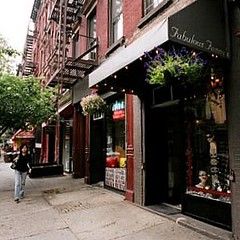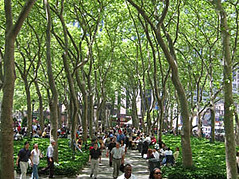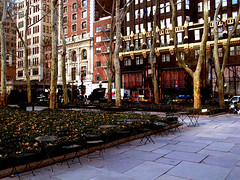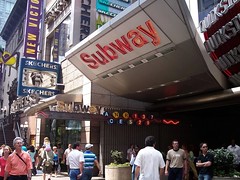Five more green apples for NYC

Posted May 1, 2008 at 5:00PM
Last week my longtime NRDC colleague Eric Goldstein posted a blog entry highlighting five laudable environmental sites (green apples) and five awful ones (bad apples). Eric got it right as usual. I am particularly a fan of his because, like me, he loves cities and, besides, he is one of a very small handful of people who were already on the NRDC staff when I first joined 27 (!) years ago.
One of Eric’s green apples is the Queens Botanical Garden Visitor Center, which I mentioned here in my last post as one of the AIA’s “ten greenest” award winners for 2008. It’s one of the good ones, by the way.
But in this post I’d like to offer a slightly (though not entirely) different perspective and cite some additional examples that I think New Yorkers may too easily take for granted as part of their environmental bounty:
Walkable neighborhoods
A lot of places don’t have them at all. New York has them in abundance, from Brooklyn Heights to the Upper West Side to Rockefeller Center to the most celebrated of them all, Greenwich Village, not counting the hundreds I either don't know or don't have space to mention. Living in a “24-hour” environment where jobs, homes, shops, schools, and other everyday conveniences are so close at hand saves time, promotes public health by encouraging walking, reduces carbon and other emissions that would otherwise come from driving, and fosters a sense of community. New York is one of the most walkable cities in the world. Take note of the fact that most Americans have to drive 20+ miles per day just to accomplish the tasks of normal living, and celebrate the difference in New York.
Awesome affordable green development
 Two such walkable neighborhoods being constructed near each other in the South Bronx deserve special mention. (Others, too, I’m sure, but these are the two I’m most familiar with.) First, pictured on the left, is Melrose Commons. The pictured bit of green housing is part of a redevelopment plan constructed by the community residents themselves -- approximately 6,000 people, primarily of African American and Latino descent, with a median family income of less than $12,000 a year. Troubled by an initial proposal that would have squeezed many of them out, they organized and took control of the situation, working to promote development that “would be sustainable, would complement the existing infrastructure and the regional location, and would provide for future growth and evolution.”
Two such walkable neighborhoods being constructed near each other in the South Bronx deserve special mention. (Others, too, I’m sure, but these are the two I’m most familiar with.) First, pictured on the left, is Melrose Commons. The pictured bit of green housing is part of a redevelopment plan constructed by the community residents themselves -- approximately 6,000 people, primarily of African American and Latino descent, with a median family income of less than $12,000 a year. Troubled by an initial proposal that would have squeezed many of them out, they organized and took control of the situation, working to promote development that “would be sustainable, would complement the existing infrastructure and the regional location, and would provide for future growth and evolution.”
Today, the plan includes: 2000 diverse housing units that are using green technology, preserving the historical richness of the community, and providing affordable options for residents of different ages and incomes; community open space that is visible from the sidewalk and linked to schools and community gardens; "greening" of industrial areas with recreational space development; business development that will employ community members in such enterprises as an after school center, health care services and recycling projects. They are also developing a town center for education and cultural uses, including the return to community use of a former YWCA building. Melrose Commons is participating in the LEED for Neighborhood Development pilot project, and they sure look deserving to me.
 Second, in the same area of the Bronx, is Via Verde, an award-winning project designed to serve a mix of incomes through a variety of unit types, including rental, co-op, and live/work town homes. Via Verde’s form is inspired by the integration of garden and city: the connected rooftops of low-rise town homes, a mid-rise duplex building, and an 18-story tower will be used to harvest rainwater, grow fruits and vegetables, to exercise, and to relax. Additional biophilic elements connecting people to nature will include private backyard gardens, semi-private courtyards, and public learning and gardening space to provide a range of outdoor experiences.
Second, in the same area of the Bronx, is Via Verde, an award-winning project designed to serve a mix of incomes through a variety of unit types, including rental, co-op, and live/work town homes. Via Verde’s form is inspired by the integration of garden and city: the connected rooftops of low-rise town homes, a mid-rise duplex building, and an 18-story tower will be used to harvest rainwater, grow fruits and vegetables, to exercise, and to relax. Additional biophilic elements connecting people to nature will include private backyard gardens, semi-private courtyards, and public learning and gardening space to provide a range of outdoor experiences.
The project, being developed by a partnership that includes my sustainability brother-in-arms, Jonathan Rose, is being designed to exceed LEED Gold standards for environmentally responsible and energy efficient design. Passive, low-tech strategies include cross ventilation in all apartments, solar shading, and aforementioned green roofs to provide insulation and control storm water. The project also incorporates high-efficiency mechanical systems, energy-conserving appliances, and renewable energy strategies, including solar voltaic canopies. In addition, smart material choices, including non-toxic paints and rapidly renewable wood products, will improve the air quality for residents and conserve natural resources. Where were these projects on the AIA’s “ten greenest” list?
Bryant Park
I really hope New Yorkers don’t take this one for granted. A shameful embarrassment in the heart of Midtown for much of the last century, this is now a treasure. To say it had fallen into hard times is an understatement. As one observer put it, “the grim joke among New Yorkers was that the police only went into the park after someone was murdered to identify the victim.” In the late 1980s, though, the welfare of the park was handed to a private entity, the Bryant Park Restoration Corporation. After a massive effort, today the eight-acre urban oasis hosts a football-field-sized lawn, twin promenades featuring the same species of trees as the Jardin des Tuileries in Paris, six flower beds planted seasonally with 100 species of woody shrubs and herbaceous perennials and 20,000 bulbs, a carousel, a boule board, chess tables, the Bryant Park Grill, free wireless access, and 2,000 moveable chairs for pausing to take in the sights. It is an astounding success and is enjoyed by thousands of visitors every day.
World-class public transportation
This one is a no-brainer. New Yorkers can not only walk, they can ride. New York’s subway system is used by over 600,000 riders per day. It is one of the most extensive public transportation systems in the world, with 468 passenger stations, 656 miles of “revenue track,” and a total of 842 miles, including non-revenue track, according to Wikipedia. The subway is also notable for being among the few rapid transit systems in the world to run 24 hours a day, 365 days a year. This, of course, is in addition to the extensive regional rail service, and more buses and bus lines than one can count. In most US communities, the share of trips taken by public transportation is under three percent. Think about it.
Really small environmental footprint
Yes, you read that heading correctly. All this adds up to what is unquestionably the most resource-efficient and low-polluting city in the country, when those measures are considered on a per capita basis. 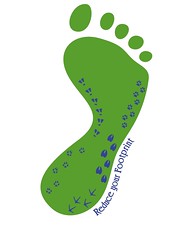 As David Owen wrote in his thoughtful article “Green Manhattan,” originally published in the New Yorker, “if you made all eight million New Yorkers live at the density of my town, they would require a space equivalent to the land area of the six New England states plus Delaware and New Jersey.” (No word on where the current residents of New England, Delaware, and New Jersey might go.) Metropolitan Phoenix, which has a population roughly twice that of Manhattan, occupies more than 200 times as much land.
As David Owen wrote in his thoughtful article “Green Manhattan,” originally published in the New Yorker, “if you made all eight million New Yorkers live at the density of my town, they would require a space equivalent to the land area of the six New England states plus Delaware and New Jersey.” (No word on where the current residents of New England, Delaware, and New Jersey might go.) Metropolitan Phoenix, which has a population roughly twice that of Manhattan, occupies more than 200 times as much land.
Owens continues, “eighty-two per cent of Manhattan residents travel to work by public transit, by bicycle, or on foot. That’s ten times the rate for Americans in general, and eight times the rate for residents of Los Angeles County. New York City is more populous than all but eleven states; if it were granted statehood, it would rank fifty-first in per-capita energy use.”
So what’s my point, anyway?
New York certainly has its share of problems, environmental and otherwise. I am extremely glad that some of my colleagues, including Eric, are working on them and solving them. But it also has some amazing environmental qualities, particularly for the US, that are not just particular spots like Queens Botanical Garden or Bryant Park, but systems producing environmental benefits. We don’t think to single them out because they are such an inherent part of the city’s fabric. But they deserve some apples, too. Don’t take them for granted, New Yorkers.

